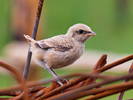search
classification
|
basic information
|
video
|
reports |
Isabelline Shrike
Lanius isabellinus (Hemprich et Ehrenberg, 1833)

|
 male
|
|
|
2009-07-05
Zabaikalsk, Zabaikalye |
© Vadim Ivushkin
|
|
Description
The adult male of Isabelline Shrike has grayish-clayey crown, nape and mantle; the forehead is yellowish-buffy, the ear coverts are black, the narrow strip under eye and spot before eye are black, the spot behind eye is white. The flight feathers are brownish with buffy edges, but bases of the primaries are buffy-white and form the little speculum some hidden by the wing coverts. The uppertail is rufous; tail is rufous brownish tinged on the end. The throat, breast and flanks are pale-buffy. The adult female is almost same the male, but generally paler above, underparts are off-white buffy tinged; the dark spots on head-sides are brownish not black; the spot over the eye is whitish-buffy not white. The bill is dark-brownish lighted on the low mandible base. Legs are brownish, eyes are brown. Juveniles in first plumage are mottled. There are brownish scaly pattern on the head and uppertail, the wing coverts are with pale centers, brownish terminal strips and pale edges. The flight feathers have brown pale buffy edges. The throat is off-white; the neck-sides, breast, abdomen and flanks have brownish scaly pattern on the dirty-whitish-buffy background. The speculum on the wing is absent. In autumn after the molting the juveniles are plain clayey above and pale-buffy below, the speculum is usually invisible. Sizes: males – wing 85-93, tail 78-92; females – wing 85-94, tail 80-86 mm. Weight 26-33.5 grams.
Biology
The Isabelline Shrike is a rarely breeding, in some areas common breeding migrant. Inhabits saxaul forests with clearings, riparian forest edges, thickets, reed beds and forest belts. Arrives early, before other shrikes, in mid February to early March in single or in loose groups of 3-5 birds. Latest observed in mid to end of April. Broods recorded in late July to early August. Autumn migrants observed after other shrikes from mid September to second half of October.
References









